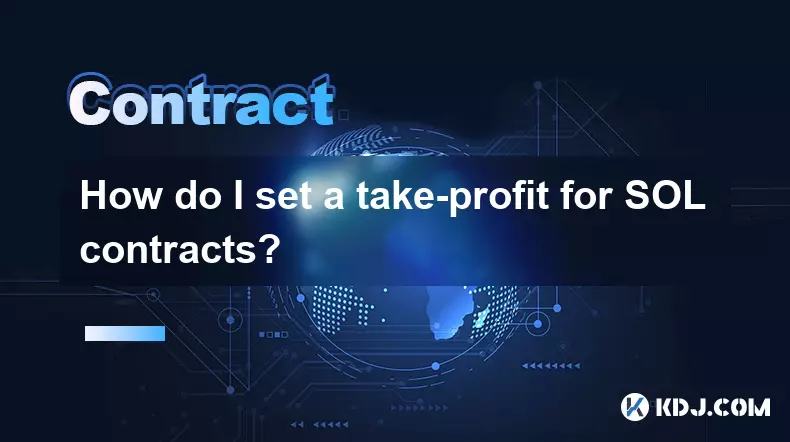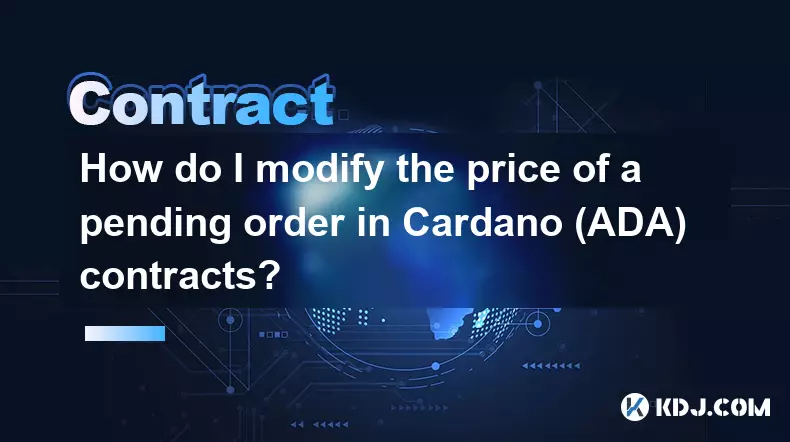-
 bitcoin
bitcoin $109523.663807 USD
-0.13% -
 ethereum
ethereum $4019.526508 USD
2.06% -
 tether
tether $1.000482 USD
0.00% -
 xrp
xrp $2.776815 USD
0.18% -
 bnb
bnb $958.942396 USD
0.12% -
 solana
solana $204.294698 USD
3.84% -
 usd-coin
usd-coin $0.999693 USD
0.00% -
 dogecoin
dogecoin $0.232115 USD
2.09% -
 tron
tron $0.338028 USD
0.84% -
 cardano
cardano $0.790920 USD
1.50% -
 hyperliquid
hyperliquid $44.871443 USD
5.60% -
 ethena-usde
ethena-usde $1.000322 USD
0.04% -
 chainlink
chainlink $21.034165 USD
2.60% -
 avalanche
avalanche $28.794831 USD
-0.54% -
 stellar
stellar $0.360466 USD
1.24%
How do I set a take-profit for SOL contracts?
Scientists have discovered a new species of deep-sea octopus, expanding our understanding of marine biodiversity in Earth's most remote ocean regions.
Sep 26, 2025 at 09:37 am

Understanding Take-Profit in SOL Futures Trading
1. A take-profit order allows traders to lock in gains when the price of Solana (SOL) reaches a predetermined level in a futures contract. This tool is essential for managing risk and ensuring profits are captured without requiring constant market monitoring. Traders using perpetual or quarterly futures contracts on exchanges like Binance, Bybit, or OKX can set this order type during position entry or after opening a trade.
2. The mechanism works by automatically closing a long position when the price rises to the specified level, or closing a short position when the price drops to the desired target. For example, if a trader opens a long position on SOL/USDT at $140 and sets a take-profit at $160, the system will execute a sell order once the mark price hits that level, assuming sufficient liquidity.
3. Most platforms offer both limit and market execution types for take-profit orders. A limit-based take-profit ensures the position closes at exactly the set price or better, though slippage may occur during high volatility. A market-based take-profit executes immediately at current market rates once triggered, which may result in slightly different fill prices but guarantees closure.
4. It's important to distinguish between mark price and last traded price when setting take-profit levels. Exchanges use the mark price to prevent manipulation and unfair liquidations. If your take-profit is based on last price instead of mark price, it might not trigger as expected during volatile conditions.
Steps to Configure a Take-Profit Order on Major Platforms
1. On Bybit, navigate to the Contracts interface, select SOL/USDT Perpetual, and open either the 'Limit' or 'Market' order tab. After choosing long or short, input the desired quantity and price. Enable the 'Take Profit / Stop Loss' toggle, then enter the target price under 'Take Profit.' Choose execution type—limit or market—and confirm.
2. In Binance Futures, go to the SOLUSDT trading pair, switch to the 'Futures' mode, and place your initial order. When filling out the order form, scroll down to the 'TP/SL' section. Enter the take-profit price in the designated field. You can also set a trigger price separate from the execution price to avoid premature triggering due to spikes.
3. On OKX, after selecting the SOL-USDT-SWAP market, open the order panel. Input size and entry type, then expand the advanced settings. Under 'Profit Taking,' specify the trigger condition (mark or last price), set the trigger price, and define the action price. This dual-layer setup helps refine precision in execution timing.
4. Some platforms support multiple take-profit levels. Traders can split their position into parts and assign different exit points. For instance, close 50% at $155, another 30% at $165, and the remainder at $180. This strategy captures incremental gains while letting part of the position run for higher returns.
Key Factors Influencing Effective Take-Profit Placement
1. Technical analysis plays a central role in determining realistic profit targets. Identify resistance zones, Fibonacci extensions, moving averages, or chart patterns that suggest where upward momentum may stall. Placing take-profit just below strong resistance increases the likelihood of execution before a reversal.
2. Volatility must be considered when setting distant targets. SOL has exhibited sharp moves within hours, especially during macroeconomic announcements or ecosystem developments. Using average true range (ATR) indicators helps gauge how far price typically travels over a given period, guiding more data-driven target selection.
3. Funding rates in perpetual markets influence short-term price direction. High positive funding indicates excessive long positioning, which may lead to a squeeze and rapid price drop. Setting take-profit ahead of anticipated funding ticks can help avoid giving back profits unexpectedly.
Traders should always verify whether their chosen exchange applies post-only rules or fees to limit-based take-profit orders. Misunderstanding fee structures can erode net gains over time, particularly in high-frequency strategies.Frequently Asked Questions
What happens if liquidity is low when my take-profit triggers?In low-liquidity scenarios, market-based take-profit orders may experience slippage, resulting in a less favorable exit price. Limit-type take-profits might not fill at all if the market gaps past the set price. Monitoring order book depth around key levels helps anticipate potential execution issues.
Can I modify a take-profit order after placing it?Yes, most exchanges allow users to edit or cancel take-profit orders while the position remains open. Access the active order section or position management tab to adjust the trigger or execution price. Changes take effect immediately upon confirmation, provided the system accepts the new parameters.
Does a take-profit order guarantee profit?No, a take-profit only guarantees execution at the specified conditions. If the market never reaches the target price, the order remains inactive. Additionally, sudden crashes or flash crashes can bypass the intended level entirely, leaving the position exposed until other risk controls intervene.
Is it possible to set a trailing take-profit on SOL contracts?Several platforms including Bybit and Binance offer trailing stop functionality that acts similarly to a dynamic take-profit. Instead of a fixed price, it follows the market price at a set distance. While not a traditional take-profit, it allows locking in profits during sustained trends while providing room for normal pullbacks.
Disclaimer:info@kdj.com
The information provided is not trading advice. kdj.com does not assume any responsibility for any investments made based on the information provided in this article. Cryptocurrencies are highly volatile and it is highly recommended that you invest with caution after thorough research!
If you believe that the content used on this website infringes your copyright, please contact us immediately (info@kdj.com) and we will delete it promptly.
- Rare 1p Coin Could Fetch £200,000: Are You Holding a Fortune?
- 2025-09-27 12:25:13
- MAGACOIN Finance: Buzz, Risks, and the Altcoin Stampede
- 2025-09-27 12:25:13
- Crypto Wallets & Utility Tokens: What's the Hype?
- 2025-09-27 12:30:02
- Shiba Inu's Burn Rate & Crypto Payroll: A New York Perspective
- 2025-09-27 12:45:11
- Grayscale, Near Protocol, and On-Chain Innovation: A New Era for Crypto?
- 2025-09-27 12:45:11
- Punjab Govt, Centre, and the Financial Package: A Tug-of-War?
- 2025-09-27 12:30:02
Related knowledge

How do I enable the "scalping-only" mode for Cardano (ADA) contracts?
Sep 24,2025 at 03:19am
Understanding Scalping Strategies in Crypto Derivatives1. Scalping in cryptocurrency trading refers to executing multiple short-term trades within min...

What is the maximum position limit for Cardano (ADA) contracts?
Sep 23,2025 at 11:00pm
Understanding ADA Futures and Derivatives Market Structure1. Cardano (ADA) futures contracts are offered by several major cryptocurrency derivatives e...

What is the maker fee for Cardano (ADA) contracts?
Sep 26,2025 at 09:01am
Understanding Maker Fees in Cardano (ADA) Contracts1. The concept of maker fees applies broadly across decentralized exchanges and smart contract plat...

How can I view open interest in Cardano (ADA) contracts?
Sep 24,2025 at 07:36am
Understanding Open Interest in Cardano Derivatives1. Open interest refers to the total number of outstanding derivative contracts, such as futures or ...

How do I modify the price of a pending order in Cardano (ADA) contracts?
Sep 27,2025 at 01:00am
Understanding Pending Orders in Cardano Smart Contracts1. Cardano operates on a proof-of-stake blockchain that supports smart contracts through its Pl...

What is the function of the insurance fund in Cardano (ADA) contracts?
Sep 24,2025 at 02:18am
Understanding the Role of Insurance Funds in Cardano Smart Contracts1. The insurance fund within Cardano's ecosystem is not a native feature directly ...

How do I enable the "scalping-only" mode for Cardano (ADA) contracts?
Sep 24,2025 at 03:19am
Understanding Scalping Strategies in Crypto Derivatives1. Scalping in cryptocurrency trading refers to executing multiple short-term trades within min...

What is the maximum position limit for Cardano (ADA) contracts?
Sep 23,2025 at 11:00pm
Understanding ADA Futures and Derivatives Market Structure1. Cardano (ADA) futures contracts are offered by several major cryptocurrency derivatives e...

What is the maker fee for Cardano (ADA) contracts?
Sep 26,2025 at 09:01am
Understanding Maker Fees in Cardano (ADA) Contracts1. The concept of maker fees applies broadly across decentralized exchanges and smart contract plat...

How can I view open interest in Cardano (ADA) contracts?
Sep 24,2025 at 07:36am
Understanding Open Interest in Cardano Derivatives1. Open interest refers to the total number of outstanding derivative contracts, such as futures or ...

How do I modify the price of a pending order in Cardano (ADA) contracts?
Sep 27,2025 at 01:00am
Understanding Pending Orders in Cardano Smart Contracts1. Cardano operates on a proof-of-stake blockchain that supports smart contracts through its Pl...

What is the function of the insurance fund in Cardano (ADA) contracts?
Sep 24,2025 at 02:18am
Understanding the Role of Insurance Funds in Cardano Smart Contracts1. The insurance fund within Cardano's ecosystem is not a native feature directly ...
See all articles










































































